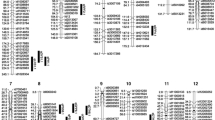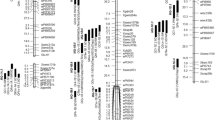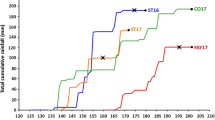Abstract
A recombinant inbred line (RIL) population, comprising 181 lines derived from ILC588 × ILC3279, was evaluated in 10 environments across three locations with different moisture gradients. A drought resistance score (DRS) and three phenology traits—plant height (PLHT), days to flowering (DFLR), and days to maturity (MAT)—were recorded along with seven yield-related traits—grain yield (GY), biological yield (BY), harvest index (HI), the number of pods/3 plants (Pod), percentage of empty pods (%Epod), 100 seed weight (100 sw), and seed number/3 plants (SN). Two RILs (152, 162) showed the best GYs and DRSs under stressed and non-stressed environments. The quantitative trait loci (QTLs) analyses detected 93 significant QTLs (LOD ≥ 2.0) across the genome × environment interactions. The highest phenotypic variation (>24 %) was explained by the QTLDFLR in Terbol-11. Four common possible pleiotropic QTLs on LG3 and LG4 were identified as associated with DFLR, DRS, GY, MAT, HI, SN, and Pod. No significant epistatic interactions were found between these QTLs and the other markers. However, the QTL for DRS was detected as a conserved QTL in three late planting environments. The markers H6C-07 (on LG3) and H5G01 (on LG4) were associated with QTLs for many traits in all environments studied except two. The allele ‘A’ of marker H6C07 (from the tolerant parent ILC588) explained 80 % of the yield increase under late planting and 29.8 % of that under dry environments. Concentrating on LG3 and LG4 in molecular breeding programs for drought could speed up improvement for these traits.





Similar content being viewed by others
References
Abbo S, Molina C, Jungmann R, Grusak MA, Berkovitch Z, Reifen R, Kahl G, Winter P (2005) Quantitative trait loci governing carotenoid concentration and weight in seeds of chickpea (Cicer arietinum L.). Theor Appl Genet 111:185–195
Arumuganathan K, Moss JP (1991) Nuclear DNA content of some important plant species. Plant Mol Biol 9:208–218
Aryamanesh N, Nelson MN, Yan G, Clarke HJ, Siddique KHM (2010) Mapping a major gene for growth habit and QTLs for Ascochyta blight resistance and flowering time in a population between chickpea and Cicer reticulatum. Euphytica 173:307–319
Blum A (1996) Crop responses to drought and the interpretation of adaptation. Plant Growth Regul 20:135–148
Blum A, Nguyen HT (2004) Physiology and biotechnology integration for plant breeding: Epilogue. In: Nguyen HT, Blum A (eds) Physiology and biotechnology integration for plant breeding. Marcel Dekker, Inc New York, pp 611–618
Boyer JS (1982) Plant productivity and environment. Science 218:443–448
Canci H, Toker C (2009) Evaluation of yield criteria for drought and heat resistance in chickpea (Cicer arietinum L.). J Agron Crop Sci 195:47–54
Ceccarelli S (1989) Wide adaptation: how wide? Euphytica 40:197–205
Ceccarelli S, Grando S (1996) Drought as a challenge for the plant breeder. Plant Growth Regul 20:149–155
Chandra BR, Nguyen BD, Chamarerk V, Shanmugasundaram P, Chezhian P, Jeyaprakash P, Ganesh SK, Palchamy A, Sadasivam S, Sarkarung S, Wade LJ, Nguyen HT (2003) Genetic analysis of drought resistance in rice by molecular markers: association between secondary traits and field performance. Crop Sci 43:1457–1469
Cho S, Kumar J, Shultz JL, Anupama K, Tefera F, Muehlbauer FJ (2002) Mapping genes for double podding and other morphological traits in chickpea. Euphytica 128:285–292
Cho S, Chen W, Muehlbauer FJ (2004) Pathotype-specific genetic factors in chickpea (Cicer arietinum L.) for quantitative resistance to ascochyta blight. Theor Appl Genet 109:733–739
Cobos MJ, Rubio J, Fernández-Romero MD, Garza R, Moreno MT, Millán T, Gil J (2007) Genetic analysis of seed size, yield and days to flowering in a chickpea recombinant inbred line population derived from a Kabuli × Desi cross. Ann Appl Biol 151:33–42
Duarte JB, Vencovsky R (1999) Interação Genótipos × Ambientes: Uma introdução à análise. AMMI. Funpec Ribeirão Preto Sociedade Brasileira de Genética
Eser D (1976) Heritability of some important plant characters, their relationship with plant yield and inheritance of ascochyta blight resistance in chickpea (Cicer arietinum L.). Ankara Universitesi, Ziraat Fakultesi Yayinlari 620, Ankara, Turkey
Gauch GH, Zobel RW (1996) AMMI analysis of yield trials. In: Kang MS, Gauch HG (eds) Genotype by environment interaction. CRC Press, Boca Raton, pp 85–122
Gaur R, Sethy NK, Choudhary S, Shokeen B, Gupta V, Bhatia S (2011) Advancing the STMS genomic resources for defining new locations on the intraspecific genetic linkage map of chickpea (Cicer arietinum L.). BMC Genomics 12:117
Gowda SJM, Radhika P, Mhase LB, Jamadagni BM, Gupta VS, Kadoo NY (2011) Mapping of QTLs governing agronomic and yield traits in chickpea. J Appl Genet 52:9–21
Gujaria N, Kumar A, Dauthal P, Dubey A, Hiremath P, Prakash AB, Farmer A, Bhide M, Shah T, Gaur PM, Upadhyaya HD, Bhatia S, Cook DR, May GD, Varshney RK (2011) Development and use of genic molecular markers (GMMs) for construction of a transcript map of chickpea (Cicer arietinum L.). Theor Appl Genet 122:1577–1589
Iruela M, Rubio J, Barro F, Cubero JI, Millán T, Gil J (2006) Detection of two QTL for resistance to Ascochyta blight in an intra-specific cross of chickpea (Cicer arietinum L.): development of SCAR markers associated to resistance. Theor Appl Genet 112:278–287
Kashiwagi J, Krishnamurthy L, Crouch JH, Serraj R (2005) Variability of root length density and its contributions to seed yield in chickpea (Cicer arietinum L.) under terminal drought stress. Field Crop Res 95:171–181
Katerji N, Van Hoorn JW, Hamdy A, Mastrorilli M, Owies T, Malhotra RS (2001) Response to soil salinity of chickpea varieties differing in drought tolerance. Agr Water Manage 50:83–96
Kaya Y, Palta C, Taner S (2002) Additive main effects and multiplicative interactions analysis of yield performances in bread wheat genotypes across environments. Turk J Agric 26:275–279
Khanna-Chopra R, Sinha SK (1987) Chickpea: physiological aspects on growth and yield. In: Saxena MC, Singh KB (eds) The Chickpea. CAB International, Wallingford, pp 163–189
Kosambi DD (1944) The estimation of map distance from recombination values. Ann Eugen 12:172–175
Kramer PJ, Boyer JS (1995) Water relations of plants and soils. Academic Press, San Diego
Kumar J, Abbo S (2001) Genetics of flowering time in chickpea and its bearing on productivity in the semi-arid environments. Adv Agron 72:107–138
Kumar J, Rao BV (1996) Super early chickpea developed at ICRISAT Asia Center. Int Chickpea Pigeonpea Newslett 3:17–18
Kumar J, Van Rheenen HA (2000) A major gene for time of flowering in chickpea. J Hered 91:67–68
Li H, Ye GY, Wang JK (2007) A modified algorithm for the improvement of composite interval mapping. Genetics 175:361–374
Lichtenzveig J, Scheuring C, Dodge J, Abbo S, Zhang HB (2005) Construction of BAC and BIBAC libraries and their applications for generation of SSR markers for genome analysis of chickpea (Cicer arietinum L.). Theor Appl Genet 110:492–510
Lichtenzveig J, Bonfil DJ, Zhang H, Shtienberg D, Abbo S (2006) Mapping quantitative trait loci in chickpea associated with time to flowering and resistance to Didymella rabiei the causal agent of Ascochyta blight. Theor Appl Genet 113:1357–1369
Ludlow MM, Muchow RC (1990) A critical evaluation of traits for improving crop yields in water-limited environments. Adv Agron 43:107–153
Mhike X, Okori P, Magorokosho C, Ndlela T (2012) Validation of the use of secondary traits and selection indices for drought tolerance in tropical maize (Zea mays L.). Af J Plant Sci 6:96–102
Muehlbauer FJ, Singh KB (1987) Genetics of chickpea. In: Saxena MC, Singh KB (eds) The chickpea. CAB International, Wallingford, pp 99–125
Or E, Hovav R, Abbo S (1999) A major gene for flowering time in chickpea. Crop Sci 39:315–322
Passioura JB (1996) Drought and drought tolerance. Plant Growth Regul 20:79–83
Polhill RM, Raven PH (1981) Advances in legume systematics. Royal Botanic Gardens, Kew
Rajesh PN, Muehlbauer FJ (2008) Discovery and detection of single nucleotide polymorphism (SNP) in coding and genomic sequences in chickpea (Cicer arietinum L.). Euphytica 162:291–300
Roberts EH, Hadley P, Summerfield RJ (1985) Effects of temperature and photoperiod on flowering in chick peas (Cicer arietinum). Ann Bot-London 55:881–892
Rogers SO, Bendich AJ (1985) Extraction of DNA from milligram amounts of fresh, herbarium and mummified plant tissues. Plant Mol Biol 5:69–76
Rubio J, Flores F, Moreno MT, Cubero JI, Gil J (2004) Effects of the erect/bushy habit, single/double pod and late/early flowering genes on yield and seed size and their stability in chickpea. Field Crop Res 90:255–262
Saxena NP (1990) Status of chickpea in the Mediterranean basin. Present status and future prospects of chickpea crop production and improvement in the Mediterranean countries. Options Méditerranéennes Série Séminaire 9:17–24
Sivapalan S, Brien LO, Ferrara GO, Hollamby GL, Barclay I, Martin PJ (2000) An adaptation analysis of Australian and CIMMYT/ICARDA wheat germplasm in Australian production environments. Aust J Agric Res 51:903–915
Toker C, Çagirgan MI (1998) Assessment of response to drought stress of chickpea (Cicer arietinum L.) lines under rainfed conditions. Turk J Agric For 22:615–621
Turner NC (1986) Crop water deficits: a decade of progress. Adv Agron 39:1–51
Turner NC, Wright GC, Siddique KHM (2001) Adaptation of grain legumes (pulses) to water limited environments. Adv Agron 71:193–231
Van Ooijen JW (2006) JoinMap 4.0, software for the calculation of genetic linkage maps. Kyazma, B.V. Wageningen, Netherlands
Van Ooijen JW (2009) MapQTL 6, software for the mapping of quantitative trait loci in experimental populations of diploid species. Kyazma, B.V. Wageningen, Netherlands
Winter P, Benko-Iseppon AM, Hüttel B, Ratnaparkhe M, Tullu A, Sonnante G, Pfaff T, Tekeoglu M, Santra D, Sant VJ, Rajesh PN, Kahl G, Muehlbauer FJ (2000) A linkage map of the chickpea (Cicer arietinum L.) genome based on the recombinant inbred lines from a C. arietinum × C. reticulatum cross: localization of resistance genes for Fusarium races 4 and 5. Theor Appl Genet 101:1155–1163
Yan W, Rajcan I (2002) Biplots analysis of the test sites and trait relations of soybean in Ontario. Crop Sci 42:11–20
Acknowledgments
The authors thank Amani Khalifeh for genotyping the RIL population and the chickpea breeding program staff for field trials of the RIL population. This work was supported by Grains Research and Development Corporation (GRDC) Australia.
Author information
Authors and Affiliations
Corresponding author
Additional information
Communicated by B. Diers.
Rights and permissions
About this article
Cite this article
Hamwieh, A., Imtiaz, M. & Malhotra, R.S. Multi-environment QTL analyses for drought-related traits in a recombinant inbred population of chickpea (Cicer arientinum L.). Theor Appl Genet 126, 1025–1038 (2013). https://doi.org/10.1007/s00122-012-2034-0
Received:
Accepted:
Published:
Issue Date:
DOI: https://doi.org/10.1007/s00122-012-2034-0




